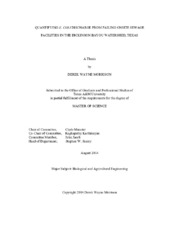| dc.contributor.advisor | Munster, Clyde | |
| dc.contributor.advisor | Karthikeyan, Raghupathy | |
| dc.creator | Morrison, Derek | |
| dc.date.accessioned | 2015-02-05T20:59:08Z | |
| dc.date.available | 2016-08-01T05:30:07Z | |
| dc.date.created | 2014-08 | |
| dc.date.issued | 2014-07-24 | |
| dc.date.submitted | August 2014 | |
| dc.identifier.uri | https://hdl.handle.net/1969.1/153586 | |
| dc.description.abstract | Since 1996, the E. coli levels in Dickinson Bayou have been considerably higher than the Texas state maximum of 126 colony forming units (CFU) per 100 mL for recreational waters. One hypothesis is that failing onsite sewage facilities (OSSFs) in the nearby residential areas are causing an increase of Escherichia coli (E. coli) concentrations in Dickinson Bayou. There are two types of OSSFs in the watershed; anaerobic and aerobic systems. The anaerobic systems discharge partially treated effluent below the soil surface from gravel drainage trenches while the aerobic systems disperse treated effluent on the soil surface using spray nozzles. This project was designed to determine if either of the two systems was contributing to the elevated E. coli concentrations in Dickinson Bayou.
Two water quality monitoring stations were installed in the Dickinson Bayou watershed to estimate E. coli concentrations in surface runoff. One of the monitoring stations was placed in a neighborhood that uses OSSFs and the second station was placed in a neighborhood connected to a municipal sewage plant. Each monitoring station was equipped with a flow meter and an automatic water sampler.
Runoff/rainfall relationships were established for each monitoring station. Water quality samples were obtained for sixteen rainfall events at the site with OSSFs and twelve events at the site with no OSSFs. Nearly all sampling events had at least one sample with an E. coli concentration greater than the state boundary. However, the concentrations from both sites were very similar to one another. A bacterial source tracking method was employed to conclude that a portion of the E. coli from both sites were of human origin. Further studies should focus on bacterial source tracking to determine the exact extent of human-based bacterial contamination in the Dickinson Bayou watershed. | en |
| dc.format.mimetype | application/pdf | |
| dc.language.iso | en | |
| dc.subject | Failing | en |
| dc.subject | Onsite | en |
| dc.subject | Sewage | en |
| dc.subject | Facilities | en |
| dc.subject | Dickinson Bayou | en |
| dc.subject | E. coli | en |
| dc.title | Quantifying E. coli Discharge from Failing Onsite Sewage Facilities in the Dickinson Bayou Watershed, Texas | en |
| dc.type | Thesis | en |
| thesis.degree.department | Biological and Agricultural Engineering | en |
| thesis.degree.discipline | Biological and Agricultural Engineering | en |
| thesis.degree.grantor | Texas A & M University | en |
| thesis.degree.name | Master of Science | en |
| thesis.degree.level | Masters | en |
| dc.contributor.committeeMember | Jacob, John | |
| dc.type.material | text | en |
| dc.date.updated | 2015-02-05T20:59:08Z | |
| local.embargo.terms | 2016-08-01 | |
| local.etdauthor.orcid | 0000-0001-6285-9484 | |


